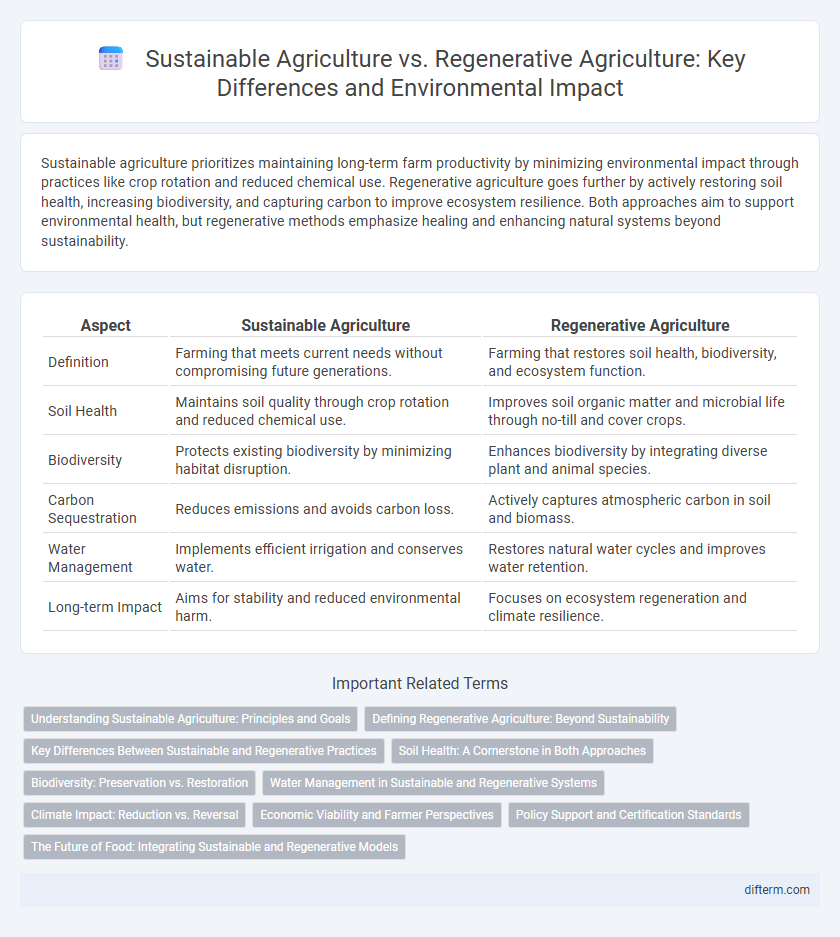Sustainable agriculture prioritizes maintaining long-term farm productivity by minimizing environmental impact through practices like crop rotation and reduced chemical use. Regenerative agriculture goes further by actively restoring soil health, increasing biodiversity, and capturing carbon to improve ecosystem resilience. Both approaches aim to support environmental health, but regenerative methods emphasize healing and enhancing natural systems beyond sustainability.
Table of Comparison
| Aspect | Sustainable Agriculture | Regenerative Agriculture |
|---|---|---|
| Definition | Farming that meets current needs without compromising future generations. | Farming that restores soil health, biodiversity, and ecosystem function. |
| Soil Health | Maintains soil quality through crop rotation and reduced chemical use. | Improves soil organic matter and microbial life through no-till and cover crops. |
| Biodiversity | Protects existing biodiversity by minimizing habitat disruption. | Enhances biodiversity by integrating diverse plant and animal species. |
| Carbon Sequestration | Reduces emissions and avoids carbon loss. | Actively captures atmospheric carbon in soil and biomass. |
| Water Management | Implements efficient irrigation and conserves water. | Restores natural water cycles and improves water retention. |
| Long-term Impact | Aims for stability and reduced environmental harm. | Focuses on ecosystem regeneration and climate resilience. |
Understanding Sustainable Agriculture: Principles and Goals
Sustainable agriculture emphasizes maintaining ecological balance by minimizing environmental impact, conserving resources, and promoting biodiversity through practices such as crop rotation and integrated pest management. Its core principles aim to produce food in a way that is economically viable, socially responsible, and environmentally sound for future generations. Key goals include soil health preservation, water conservation, and reducing chemical inputs to ensure long-term agricultural productivity.
Defining Regenerative Agriculture: Beyond Sustainability
Regenerative agriculture goes beyond sustainability by actively restoring soil health, increasing biodiversity, and enhancing ecosystem services through practices like cover cropping, crop rotation, and reduced tillage. It emphasizes carbon sequestration and resilience against climate change, aiming to rebuild natural systems rather than merely maintaining current conditions. This approach contrasts with sustainable agriculture, which primarily focuses on minimizing negative impacts without necessarily improving the environment.
Key Differences Between Sustainable and Regenerative Practices
Sustainable agriculture prioritizes resource conservation, minimizing environmental impact through practices like crop rotation and reduced chemical inputs to maintain long-term productivity. Regenerative agriculture goes further by actively restoring soil health, increasing biodiversity, and capturing carbon, aiming to reverse ecosystem degradation. Key differences lie in regenerative methods' focus on ecosystem restoration and enhancement versus sustainable agriculture's goal of maintenance and prevention.
Soil Health: A Cornerstone in Both Approaches
Sustainable agriculture prioritizes maintaining soil health through practices like crop rotation, cover cropping, and reduced chemical inputs to minimize degradation and preserve fertility. Regenerative agriculture goes further by actively restoring soil ecosystems via techniques such as agroforestry, compost application, and minimal tillage to enhance biodiversity, carbon sequestration, and nutrient cycling. Both approaches recognize soil health as essential for long-term productivity, climate resilience, and environmental sustainability.
Biodiversity: Preservation vs. Restoration
Sustainable agriculture emphasizes the preservation of existing biodiversity by maintaining soil health and minimizing chemical inputs to protect natural ecosystems. Regenerative agriculture focuses on actively restoring biodiversity through practices like cover cropping, crop rotation, and integrating livestock to rebuild soil organic matter and enhance habitat complexity. Both approaches aim to support ecosystem services, but regenerative agriculture prioritizes reversing degradation and increasing biodiversity resilience over time.
Water Management in Sustainable and Regenerative Systems
Sustainable agriculture emphasizes efficient water use through practices like drip irrigation and rainwater harvesting to minimize waste and conserve resources. Regenerative agriculture enhances water retention and soil moisture by promoting biodiversity, cover cropping, and no-till farming, which improves the land's natural ability to manage water cycles. Both systems aim to protect water quality and reduce runoff, but regenerative methods focus more on restoring ecosystem health to create resilient water management.
Climate Impact: Reduction vs. Reversal
Sustainable agriculture focuses on reducing the negative climate impact by minimizing greenhouse gas emissions and conserving resources. Regenerative agriculture goes further by actively reversing climate change effects through soil carbon sequestration and enhancing biodiversity. This transformative approach not only lowers emissions but also restores ecosystem health and resilience.
Economic Viability and Farmer Perspectives
Sustainable agriculture emphasizes resource efficiency and cost reduction to enhance economic viability, while regenerative agriculture focuses on long-term soil health and biodiversity, potentially increasing farm resilience and profitability over time. Farmers adopting regenerative practices report higher upfront costs but observe improved yields and reduced dependency on chemical inputs, contributing to economic sustainability. Market demand for regenerative products and carbon credit opportunities further influence farmer perspectives, making regenerative agriculture a viable economic option.
Policy Support and Certification Standards
Policy support for sustainable agriculture emphasizes resource efficiency and reducing environmental impact through subsidies and regulatory incentives, while regenerative agriculture policies prioritize soil health restoration, biodiversity enhancement, and carbon sequestration. Certification standards for sustainable agriculture often focus on minimizing chemical inputs and conserving water, whereas regenerative certifications require adherence to practices that rebuild organic soil matter and promote ecosystem resilience. Both frameworks increasingly incorporate scientific metrics and stakeholder collaboration to align agricultural practices with climate goals and food security objectives.
The Future of Food: Integrating Sustainable and Regenerative Models
Sustainable agriculture emphasizes practices that maintain environmental health and resource efficiency, such as crop rotation and reduced chemical inputs, to ensure long-term food security. Regenerative agriculture goes further by actively restoring soil biodiversity, enhancing carbon sequestration, and improving ecosystem resilience through techniques like cover cropping and holistic grazing. Integrating these models supports a future food system that not only preserves resources but also revitalizes landscapes, promoting climate resilience and sustainable yield growth.
sustainable agriculture vs regenerative agriculture Infographic

 difterm.com
difterm.com